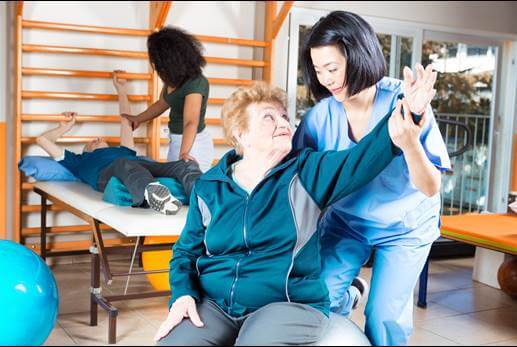Stroke is one of the most common causes of long-term disability in the United States, affecting nearly 800,000 people a year. In 2019, stroke was the cause of death for about 150,000 Americans, accounting for 1 in 20 deaths according to the Center for Disease Control (CDC). Learn more about what causes stroke, its potential effects, and the rehabilitation process.
What Causes a Stroke?
A stroke occurs as the result of inadequate blood flow to the brain. Blood is important because it contains the oxygen that the brain needs to function. When this blood supply is interrupted, brain tissue is damaged and brain cells will begin to die within minutes due to lack of oxygen. This can occur one of two ways. The first and most common cause is when blood vessels are narrowed or blocked due to blood clots or fatty deposits. The resulting reduction in blood flow is known as ischemia and as a result, this is known as an ischemic stroke. Stroke can also be caused when a blood vessel within the brain bursts or leaks. This is known as a hemorrhage, and the build up of blood within the brain that follows can cause damage to the brain tissue (a hemorrhagic stroke).
What Are the Long-Term Effects of Stroke?
Stroke can lead to numerous disabilities depending on the location of the stroke in the brain and the amount of time the brain did not have oxygen. These disabilities may be temporary or permanent. Common impairments include:
- Muscle weakness or complete paralysis, usually on one side of the body
- Cognitive difficulties such as memory loss, poor judgement, poor concentration and difficulty with reasoning or problem solving
- Emotional lability or difficulty controlling/expressing emotions
- Trouble speaking or understanding speech
- Trouble eating or drinking
- Pain or discomfort including numbness
These can affect an individual’s ability to perform self care activities such as bathing and dressing, move around their home and their community, and participate in work, hobbies, or other activities. Rehabilitation following a stroke is focused on addressing these deficits and typically includes speech, occupational, and physical therapy.
Physical Therapy’s Role in Stroke
The goal of physical therapy is to help the survivor relearn and recover functional movements and coordination in order to be as independent as possible. A rehabilitation program will be personalized to meet the needs of the individual, and may include:
- Stretching and Strengthening of muscles to optimize functioning
- Gait Training to relearn and improve walking pattern
- Balance Training to improve balance and decrease fall risk
- Functional Training to allow practice of daily activities such as transferring from sitting to standing and moving out of the bed
- Patient Education on proper positioning, use of assistive devices (cane, walker, etc.), home modifications for safety, and other important information
If you have suffered a stroke and are looking to improve your function and quality of life and regain independence, call Respire Physical Therapy at (703) 671-1871 or click here to schedule your one-on-one evaluation today!
Tags: respirept, stroke, #rehab, Physical Therapy, #ptworks, physical therapist, #functionaltraining, #gaittraining, choosept, #strengthen, arlingtonva, alexandriava, springfieldva, fallschurchva



